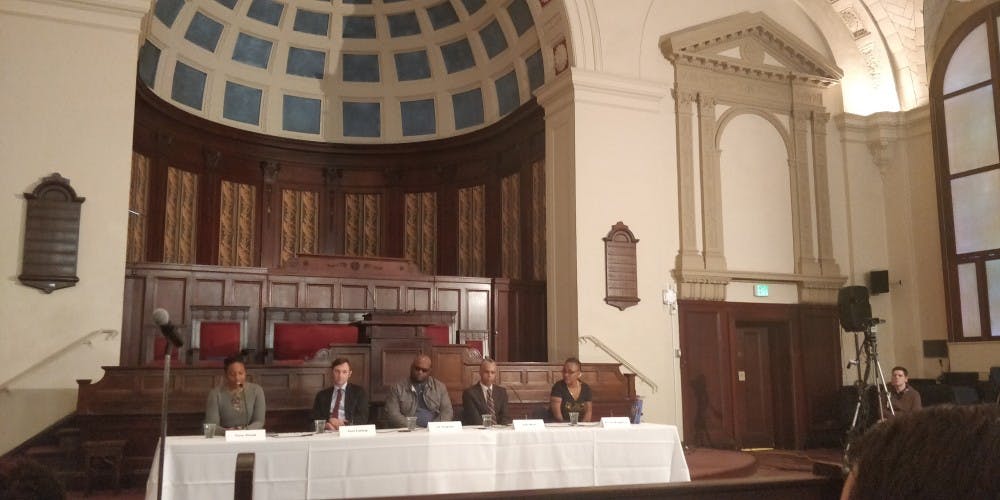Five panelists discussed ways to help end violence in Baltimore this Wednesday in the final event of the University-led discussion series on policing. The event aimed to approach the issue of crime in Baltimore from a public health perspective and to focus on the University’s relationship with the city.
The panel included Carla Shedd, sociologist at the City University of New York; Jens Ludwig, an economist at the University of Chicago; JT Timpson, director of youth work and crisis intervention for the anti-violence nonprofit Baltimore Roca; John Rich, a physician and professor of health management at Drexel University Dornsife School of Public Health; and Erricka Bridgeford, director of Baltimore Ceasefire. The conversation was moderated by Bloomberg Distinguished Professor Lisa Cooper, who focuses on America’s health disparities.
All of the panelists have done work to research and develop methods to counter urban poverty and violence, particularly in black communities.
Bridgeford’s work with Baltimore Ceasefire aims to reduce gun violence in the city. She believes that the whole system of policing needs to be dismantled and reconstructed to better serve Baltimore residents. Because of this, she feels that a private police force at the University will ultimately be more harmful than helpful.
“I can speak from the perspective as a Baltimore native on how Baltimore residents view Hopkins. We think that there’s this bubble. Hopkins has a lot of resources, so to see a place like Hopkins add more and more police says to us that y’all want to come here, you understand how wonderful Baltimore is, but you want to make sure that there are enough police here so that you have a buffer between you and the people who actually live here,” Bridgeford said.
Bridgeford also critiqued students for not exploring Baltimore during their time in the city, instead choosing to stay on Hopkins campuses.
“Don’t just come and suck up all the resources and bail and just say ‘I went to Hopkins.’ We don’t care that you went to Hopkins. What did you do for this city, or were you just a leech?” she said.
Jens Ludwig commented that the issue between universities and urban communities is common in many cities in the U.S.
“The challenge for these universities is they’re not drawing on people from Baltimore. They’re drawing on people from all over the United States and all over the world,” he said.
Ludwig explained that many international students and students from wealthy neighborhoods come to university campuses and feel that these campuses are relatively unsafe compared to where they come from.
He further suggested that many of the disparities within Baltimore come from systemic issues and that the only way to ultimately fix them is to address larger social issues, as opposed to increasing policing.
Timpson spoke about different strategies to make social intervention more effective. In particular, he described the strategies he and his organization, Baltimore Roca, use to help at-risk youth who are traumatized by the violence they see going on around them.
“What we have to do first is understand the conditions of these communities and the people in these communities. And the only way we can do that is by going into these communities and finding out from people what it is that they need,” Timpson said.
He explained that his work involves dealing with people who often don’t initially want to participate in the programs offered by Baltimore Roca.
“In Baltimore there’s plenty of programs for people who can show up. For people who can wake up in the morning and get there themselves,” Timpson said. “But what we have to understand is that a lot of young people here are not able to do that just based on the condition that they are in. They can’t show up. They don’t know how to.”
He stressed that it was important to give people a space in which they could build relationships with non-judgemental people who genuinely want to help them.
“We have to let young people know that they are safe enough in this space and that their feelings are important,” he said.
John Rich noted that the best way to address violence in cities is by targeting institutions that are designed to hurt people of color.
“The reality of this situation of built-in racism means that not everybody feels safer around the police,” he said.
He explained that even though black and brown people are more likely to be victims of violence, they are often treated as though they are the perpetrators. Rich believed that large institutions like Hopkins have a unique potential to help these marginalized groups.
“We should think about the ways in which other institutions can help address these issues. Universities and hospitals are anchor institutions, and they can play a powerful role in addressing the needs of young people who are victims,” he said.
Senior Kristyn Green appreciated the discussion but wished that more practical solutions were discussed.
“The conversation was interesting, and it definitely did open up to different perspectives, but a lot of it ended up being Hopkins specific,” she said. “I think that it’s interesting that they didn’t really talk much about [people] younger than teenagers, because they were very dead set that these problems are systematic, and systematic doesn’t start at high school, it starts at parents and children in elementary school.”
Senior Joanna Ye also commented on the lack of concrete solutions proposed during the discussion.
“I think that there is a consensus among all the panelists that there are social and economic problems that need to be addressed in order to build a better relationship between the community and the police. However, I wish there could have been more granularity in how this might be achieved,” she said. “That’s what I was coming here to learn about. I don’t think that, ultimately, there were very discrete solutions to this very big problem.”





